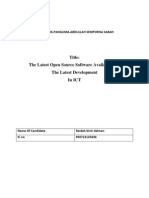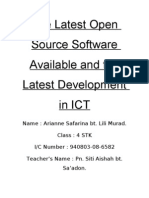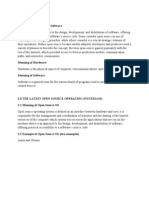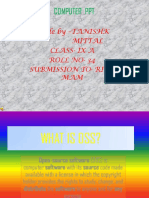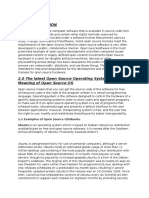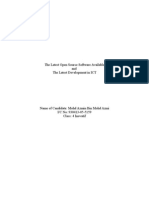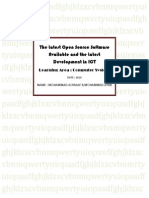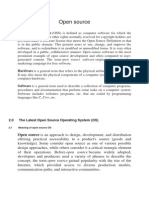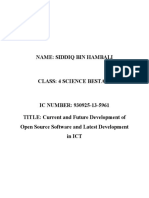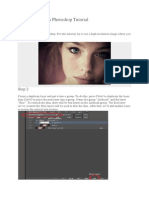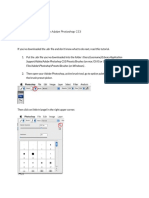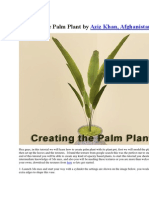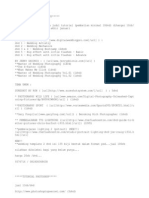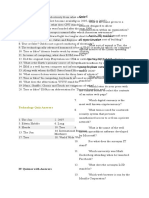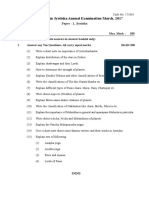Current and Future Development Open Source Software and Latest
Development in ICT
Name : NUR FITRI HANIS BINTI MUHAMAD NOR
Class : 4 VLE
No IC : 000112-14-0236
TABLE OF CONTENT
CONTENT PAGE
1.0 Introduction
3
(meaning of open source software, hardware, software)
2.0 The Latest Open Source Operating System (OS)
4/5/
2.1 Meaning of Open Source OS
2.2 Examples of open source OS (two examples) 6
3.0 The Latest Open Source Application Software
7/8
3.1 Meaning of open source application software
3.2 Examples of open source application software (two examples)
4.0 The Latest Development in ICT
9/10
4.1 Hardware
4.2 Software
5.0 Pervasive Computing
11/1
5.1 Meaning of pervasive computing
5.2 Examples of pervasive computing 2
6.0 Conclusion
13
2
References
14
1.0 INTRODUCTION
Meaning of open source software
Open source software (OSS) refers to software that is developed, tested, or improved
through public collaboration and distributed with the idea that the must be shared with
others, ensuring an open future collaboration. The collaborative experience of many
developers, especially those in the academic environment, in developing various versions of
the UNIX operating system, Richard Stallman's idea of Free Software Foundation, and the
desire of users to freely choose among a number of products - all of these led to the Open
Source movement and the approach to developing and distributing programs as open source
software.
Meaning of hardware
In information technology, hardware is the physical aspect of computers,
telecommunications, and other devices. The term arose as a way to distinguish the "box" and
3
the electronic circuitry and components of a computer from the program you put in it to
make it do things. The program came to be known as the software.
Meaning of software
Software is a general term for the various kinds of programs used to operate computers and
related devices. (The term hardware describes the physical aspects of computers and related
devices.)
4
2.0 The Latest Open Source Operating System (OS)
2.1 Meaning of open source operating system
An operating system is a set of programs containing instructions that coordinate all the activities
among computer hardware resources. Most operating system perform similar function that
includes starting a computer, provide a user interface, managing program, managing memory
and configuring devices. Some operating system also allows user to control a network and
administer security.
5
2.2Examples of open source operating system
Name of the open source OS: Explaination:
1.Ubuntu
2.
Ubuntu 16.04 is the 6th Long Term
Name (version): 16.04 LTS Support (LTS) release of Ubuntu. In a certain
sense, the LTS release is the flagship version
Release date : April 2016 of Ubuntu that sees a new release in every 2
years, and each release is backed by 5 years of
support, opposed to the 9 month support of the
normal Ubuntu release that sees a new face in
every 6 months. This means greater security
and reliability as it allows the two packaging
formats which are snap packages and
traditional deb packages to live comfortably
next to one another which enables us to
maintain our existing processes for
development and updates to the OS. This
reinforces the relationship with the Debian
community and it enables developers and
communities to publish either debs or snaps
for the Ubuntu audience.
6
7
Name (Version): fedora 24
Date release : July 2016 The Fedora 24 Workstation release features
GNOME 3.20, with many usability
improvements such as easier input device and
printer settings, a better search interface,
shortcut windows for keyboard commands,
and more convenient music controls.
Flatpak (formerly xdg-app) is another
building-block feature, with Software able to
track installed Flatpaks and adding more
features in the future as the technology
develops. The Software app has also grown
features to provide a full system upgrade
directly from the desktop from one Fedora
release to the next, and the ability to provide
labeling as well as reviews of available
software.
8
3.0 The Latest Open Source Application Software
3.1 Meaning of open source application software
Open source application software is computer software that is available in source code form
for which the source code and certain other rights normally reserved for copyright holders
are provided under a software license that permits users to study, change, and improve the
software. Some open source application software is available within the public domain.
Open source application software is very often developed in a public and collaborative
manner. Open source application software is the most prominent example of open source
development and often compared to user-generated content or open content movements. The
term open source application softwareoriginated as part of a marketing campaign for free
application software.
9
3.2 Examples of open source application software
Name of the open source application Explaination:
software:
Blender is the free and open source 3D
creation suite. It supports the entirety of the
Name + Version : 2.77a 3D pipeline—modeling, rigging, animation,
simulation, rendering, compositing and
motion tracking, even video editing and
game creation. Advanced users employ
Blender’s API for Python scripting to
customize the application and write
specialized tools; often these are included in
Blender’s future releases. Blender is well
suited to individuals and small studios who
benefit from its unified pipeline and
responsive development process. Examples
from many Blender-based projects are
available in the showcase.
Date release: june 2016
Name + Version : 1.11.2 [
Docker provides an additional layer of
abstraction and automation
10
ofoperating-system-level
virtualization on Linux.[6]
Docker uses the
resource isolation features of the Linux
kernel such as cgroups and
kernel namespaces, and a union-capable file
system such as aufs and others[7] to allow
independent "containers" to run within a
single Linux instance, avoiding the
overhead of starting and maintaining virtual
machines.[8]
Date release: May 2016
11
4.0 The Latest Development in ICT
3.2 Hardware
Latest model Previous model
Name of hardware: GoPro 3 Name of Hardware: canon EOS 7D
Date Produce: 2015 Date Produce:2014
Picture: Picture:
Specification/special features: Specification/special features:
Starting with the sensor, the camera is told to The Canon 7d is designed for speed processing of
read a certain window of the overall sensor the these lage 14-bit files,as well as keep up with the
bigger the window , the more taxing it is on the shutter’s 8-frame-per-second top speed .even the
processor . Reading the full sensor means you’re sensor had to tweaked to enable such speed , with
12
getting the full view coming from the wide angle an 8-channel readout to more quickly draw the
lens of the GoPro . The sensor in the HERO 3 image off the sensor . The canon 7D’s buffer can
Black edition is 12MP with a 4;3 aspect ratio/ for hanle 94 JPEGs at top speed , or 15RAW images.
4k in the GoPro it’s reading the full width of the For its part ,the Canon 7D’s shutter mechanism is
sensor , but not the full height – it’s capturing a rated at 150,00 cycles ,and and is capable of
16:9 portion of the middle of the 4:3 full sensor speeds up to 1/8000 sec, with a flash sync speed
of 1/250 sec.
4.2 Software
Latest version Previous version
Name of software: Adobe photoshop Name of software: Adobe photoshop CC 2014
CC2015
Date of Release: June 2014
Date of Release: June 2015
13
Adobe added several features including CC 2014 features improvements to content
Adobe Stock . which is a library of custom aware tools , two new blur tools(spin blur and
stock images . They also added the ability to path blur) and a new focis mask feature that
have more than one layer style for example enables the user to select parts of an image
in the older version of photo shop , only one based on whether they are in focus or not , other
shadow could be used for layer but in CC minor improvements have been made including
2015 ,up to ten are available. speed increase for certain tasks
4.0 Pervasive computing
4.1 Meaning of pervasive computing
Pervasive computing (also called ubiquitous computing) is the growing trend towards
embedding microprocessors in everyday objects so they can communicate information.
14
The words pervasive and ubiquitous mean "existing everywhere." Pervasive
computing devices are completely connected and constantly available.
15
4.2 Examples of Pervasive computing
1. Smart Shoe 2. Smartglasses
Pic:
Pic:
Smart shoe is a smart technology footwear in
which shoe insoles are connected to a smartphone Smartglasses or smart glasses or Digital Eye
application that uses Google maps, and vibrate to
Glass or Personal Imaging System are a wearable
tell users when and where to turn to reach their
destination computer that adds information to what the wearer
sees. Typically this is achieved through anoptical
head-mounted display (OHMD)
or computerized internet-connected glasses with
transparent heads-up display (HUD) oraugmented
reality (AR) overlay that has the capability of
reflecting projected digital images as well as
allowing the user to see through it, or see better
with it.
16
17
5.0 Conclusion
The improvement of development in ICT not only help us through by resolve our daily life
faster and easier but also have create paperless enviroment naturally good for our future.
Open Source can be used by anyone and because it has no copyright claims, so users are free
to use, change, and improve the software, and to redistribute it in modified or unmodified
forms. Pervasive Computing is to make our lives easier because we can interact with
computers. Besides that, we can easily give the computer commands and the computer will
grant your wish.
18
REFERENCES
http://searchenterpriselinux.techtarget.com/definition/open-source-software
http://searchsoa.techtarget.com/definition/software
http://searchnetworking.techtarget.com/definition/hardware
http://www.ubuntu.com/server
https://insights.ubuntu.com/2016/04/29/lts-16-04-review-roundup/
https://en.wikipedia.org/wiki/Smart_shoe
http://internetofthingsagenda.techtarget.com/definition/pervasive-computing-
ubiquitous-computing
https://en.wikipedia.org/wiki/Smartglasses
https://fedoramagazine.org/fedora-24-released/
https://en.wikipedia.org/wiki/Docker_
https://en.wikipedia.org/wiki/Blender
http://www.adobe.com/products/photoshop/features.html
19
20



